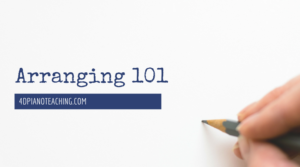Arranging. The word seems to scare my students to death sometimes! They believe that only the amazing Kevin Olsen or Carol Matz can arrange a tune they are familiar with into something they can play. When I gave out our first arranging assignment of the semester, several students looked defeated already or just turned to me with big, wide eyes full of disbelief. Now once I explained what the exact project we were tackling was, they went home ready to do the first few steps. But it did take some convincing for most of my students – they just didn’t believe it was something they could do when they weren’t advanced players.
Figuring out how to arrange a familiar tune/song is such a vital skill in my opinion. I always hope that my students will become well rounded adults who never say, “Well I took piano lessons for years but now I can’t play anything…” Ahhh! If I ever hear that, I’ll feel really disappointed. Sure, they may not be able to still remember every note of recital songs but we work on much more than that in lessons right?! One skill I’ve found that students love to keep applying outside of lessons is playing by ear. Now to some students it comes naturally. To others, we’ve worked to develop it slowly and this activity really helps.
We begin with a page of music staff paper. We choose an easy key and a simple tune. Last semester, we did Christmas songs the children knew really well. This semester, most students chose folk songs or nursery rhymes. Most were short and simple but had a tune to it. I also should add, that we often do the Happy Birthday song – it’s so fun when they can play it for family birthdays! We often choose the key of C for these assignments to make it easier so in the lesson, we’ll start by figuring out the first few notes. Then I send them home to write out the other notes with lyrics under it.
 Some students come back having hammered out the entire song. Others need a bit more help the next week. But once it’s done, we practice playing it with the RH alone. Then we add chords – just I and V7 for the younger students. (It’s a great way to show them how useful those chord cadences are that we make them practice in every key!) Older students are able to branch out to add IV and then even more adventurous chords.
Some students come back having hammered out the entire song. Others need a bit more help the next week. But once it’s done, we practice playing it with the RH alone. Then we add chords – just I and V7 for the younger students. (It’s a great way to show them how useful those chord cadences are that we make them practice in every key!) Older students are able to branch out to add IV and then even more adventurous chords.
Now after they’ve harmonized the melody, here comes the fun part! Arranging it. We can take it so many ways from here and make it really unique. First pick what style or type of sound they want – Jazz? Pop? Classical? Baroque? Romantic? Country? There are so many ways to go from here as they change up the LH – they can move octaves in either hand, they can change the rhythm in the RH a bit to match the LH, they can move the melody to the LH for a bit and let the RH try accompanying, add a few extra notes between big jumps, add a few grace notes, and so on. There’s no end to how creative they can get!
You probably have several ideas to make these sounds with students but here are a few of my favorite go-to’s:
**Boogie sound
LH plays the boogie with a simple pattern repeated over and over. {C C E F F# G} Transpose to whatever key the student chose and move for the dominant key.
**Classical sound
Pull out that Alberti Bass that they practiced so much in their last sonatina! Help them realize the pattern {C G E G} repeats and break up whatever chords they’re using.
**Pop sound
For our beginning arrangements, I like to have them use a dotted rhythm to syncopate the chords in the LH. I show them a few options and let them play with it, even breaking up chords with the syncopated rhythm if they want to. The RH can be syncopated as well to arrange the melody even more.
 So today I wanted to share a simple printable that I’ve developed to hand to my students. When I have copies of this prepared, it makes it easy to just hand that to the student and it has the steps we will follow all written out. There really is no wrong way to arrange a tune – make sure to tell your students this and be excited for whatever they bring back! I’ve found the trick to composing and arranging really begins with just doing it. Once they get over the fear of “doing it wrong” most students really enjoy expressing themselves creatively through music they are making themselves!
So today I wanted to share a simple printable that I’ve developed to hand to my students. When I have copies of this prepared, it makes it easy to just hand that to the student and it has the steps we will follow all written out. There really is no wrong way to arrange a tune – make sure to tell your students this and be excited for whatever they bring back! I’ve found the trick to composing and arranging really begins with just doing it. Once they get over the fear of “doing it wrong” most students really enjoy expressing themselves creatively through music they are making themselves!
And one last note – with very beginner students, try just having them do ear training practice by figuring out melodies. Then you as the teacher can add the harmonization in duet form and try changing up the style! It’s a really fun way to just get them started on this arranging adventure!
So really, print this free printable off and get started today in your studio! Maybe you’ll find the next Phillip Keveren 😉
Download here: Arranging 101
Author: Whitney
Whitney Hawker, NCTM, teaches group and private piano at Weber State University, Utah. She loves surprising students with the perfect piece or a new exciting game! After graduate school, she missed sharing ideas and resources daily with colleagues so she and her friend, Spring, began blogging together at 4DPianoTeaching.com


I love how creative this activity is. Thank you for sharing Whitney!